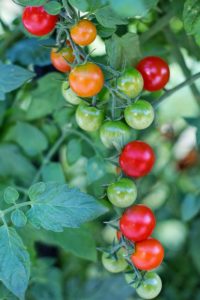Nothing beats the taste of fresh, juicy, home-grown tomatoes, so it’s no surprise that tomatoes are a favorite amongst home gardeners. Unfortunately, growing tomatoes doesn’t come without its challenges. Between garden pests, tomato diseases and other trials and tribulations,  it’s common for gardeners to be presented with challenges growing tomato plants.
it’s common for gardeners to be presented with challenges growing tomato plants.
Have you ever walked out to your garden only to find brown spots on the tomatoes’ leaves, along with a few yellow leaves? Or flowers, but no tomatoes? Perhaps you walked out to your garden to find your luscious tomatoes with crack marks? No matter what the issue is, most of these tomato challenges can be prevented or fixed.
Below are some common examples of challenges gardeners are faced with while growing tomatoes, along with some possible solutions.
Common Tomato Garden Problems
Fruit Cracks
There are two types of fruit cracking that gardeners might find on their tomatoes; radial or concentric. Radial cracks start at the end of the stem and move downward, while concentric cracks appear in a circular pattern at the top of the tomato. Both types of fruit cracking will cause the tomato to rot before they reach their peak ripeness. Some tomato varieties are resistant to cracking, and fruit cracks are unavoidable in others. However, gardeners can prevent fruit cracks by adequately watering, fertilizing and mulching.
Tomato Diseases
Tomato diseases such as Chlorosis, Early Blight, Late Blight, Septoria, Leaf Spot, Anthracnose, Blossom End Rot and Bacterial Speck are all able to be fixed if caught early enough. While some diseases affect the leaves of the tomato plant, others effect the fruit itself. Signs of an infected tomato plant range from black spots on the leaves to wilted leaves, so if you notice any irregularity with the foliage or fruit of your tomato plants, talk to any of our tomato seed suppliers about what the issue could be and how to fix it.
Garden Pests
Insect garden pests are usually a culprit for farmers having issues with growing tomatoes. There are many pesticides, even non-toxic or organic pesticides that gardeners can use to spray the tomato plant and prevent an infestation of insects. Cutworms, beetles and spider mites are just a few examples of detrimental insects. It is important, however, to differentiate between harmful insects and beneficial insects. Attracting the “good bugs” can act as an organic pesticide and serve as a better method of pest management in your garden.
Catfacing/Misshapen
Colder temperatures are usually the culprit for misshapen tomato plants. There are some tomato seed varieties that are more prone to being misshapen, such as some heirloom varieties and beefsteak tomato plant varieties. If your tomato seeds are planted when temperatures are higher, or above 60 degrees Fahrenheit, growing misshapen fruit can be avoided. Catfacing specifically refers to deformed tomatoes that appear to have crevices on the ends.
Sunscalding
Just like humans get sunburned on our skin, tomato plants get sunscalding, or a pruned, leathery and infected area at the top of the fruit. The cause of sunscalding is, you guessed it, too much direct exposure to sunlight or hot temperatures. If the temperatures in your area are on the rise, try to keep your tomatoes shaded enough to avoid sunscalding. In addition, avoid over-pruning your tomato plants or cage them. Once tomatoes are impacted by sunscalding, there’s no way to fix it.
Be sure to check out some of the great tomato seed suppliers we have in our seed supplier catalog! Garden Savvy allows you to browse and compare thousands of verified vendors to see prices, inventory, and more. All with real, honest reviews from customers.
Recent Posts
- Smart Gardening: How Technology Is Revolutionizing Horticulture
- Understanding Gardening Zones: What You Need to Know
- The Right Tools For Your Gardening And Landscaping Needs
- Maximizing Your Harvest: Square Foot Gardening Chart for Beginners
- Holiday Garden Scents: Plants for Natural Aromatherapy in Your Home






